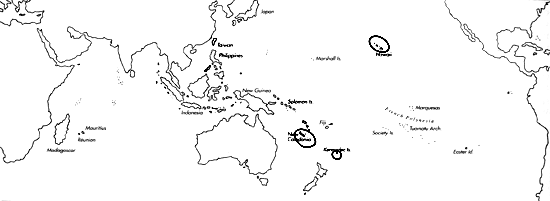
Skip Navigation Links
View access keys for this site.

Range: Confirmed only from the type locality; shells from Midway Id. and Oahu (Hawaii), New Caledonia, and the New Zealand area (Wanganella Bank, Kermadec Ridge) may refer to this species.
Description: Moderately large, moderately solid. Last whorl slightly pyriform, outline convex adapically, slightly concave below. Shoulder indistinct from spire but with a prominent edge. Spire high, outline almost straight. Larval shell of more than 2 whorls, maximum diameter about 1.1 mm (shells from New Caledonia). First 5-6 postnuclear whorls tuberculate. Teleoconch sutural ramps flat, with 1-2 increasing to 4-6 spiral grooves, obsolete in late whorls. Last whorl with spiral ribs on basal third, followed by spiral threads to shoulder.
| Shell Morphometry | ||
|---|---|---|
| L | 61- mm | |
| ((Holotype)) | ||
| RW | - | |
| RD | 0.51- | |
| PMD | 0.90- | |
| RSH | 0.27- | |
Ground colour white. Larval whorls light brown. Last whorl with a broad pale brown spiral band on each side of centre. Aperture white.
Periostracum olive-brown, thin, somewhat translucent, smooth.
Habitat and Habits: In 470-570 m (holotype).
Discussion: C. smirna is hard to separate from similarly shaped and probably related species. For comparison to C. lani, C. profundorum, C. ikedai, C. scopulicola, C. darkini, and C. jeanmartini, see the Discussions of those species. Walls, [1979] figured a specimen from S.W. of Midway Id., Hawaii as representative of "typical" Hawaiian C. smirna. A somewhat smaller, but otherwise closely corresponding shell (Pl. 27, Figs. 8, 9) was collected in 510 m near Oahu, Hawaii. These shells differ from the holotype of C. smirna (Pl. 27, Figs. 4, 5) mainly in their broader and ventricosely conical to conical last whorls, their darker brown spiral bands, pale brown aperture, and less distinct shoulder edge; they resemble the type of C. profundorum, and their assignment to C. smirna remains doubtful. Specimens collected outside the New Caledonian lagoon in 545-560 m (Pl. 27, Fig. 7) were identified as C. smirna (Richer de Forges & Estival, 1986: Richard, 1990). They correspond with C. smirna in relative diameter and outline of the last whorl, in size and in relative spire height. They differ in their more ventricose shape (PMD 0.8 1-0.86 vs. 0.90), the absence of spiral grooves on sutural ramps, and in theaxial as well as spiral arrangement of their pattern. Their assignment to C. smirna also remains doubtful. Similar specimens from subtropical waters north of New Zealand (Pl. 27, Fig. 6) live in 200- 1,180 m. They recall the New Caledonian shells in pattern, sculpture and shape except for their broader last whorl (RD 0.55-0.61). According to Marshall (1981), their multispiral larval shell excludes conspecificity with the similar C. scopulicola; he assigned them to C. smirna, which he considered conspecific with C. profundorum. Their relatedness to the shells from the New Caledonian area as well as to C. smirna needs further research.

C. smirna range map
This section contains verbatim reproductions of the accounts of 316 species of Conus from the Indo-Pacific region, from Manual of the Living Conidae, by Röckel, Korn and Kohn (1995). They are reproduced with the kind permission of the present publisher, Conchbooks.
All plates and figures referred to in the text are also in Röckel, Korn & Kohn, 1995. Manual of the Living Conidae Vol. 1: Indo-Pacific Region.
The range maps have been modified so that each species account has it own map, rather than one map that showed the ranges of several species in the original work. This was necessary because each species account is on a separate page on the website and not confined to the order of accounts in the book.
Return to framed version (returns to search page)